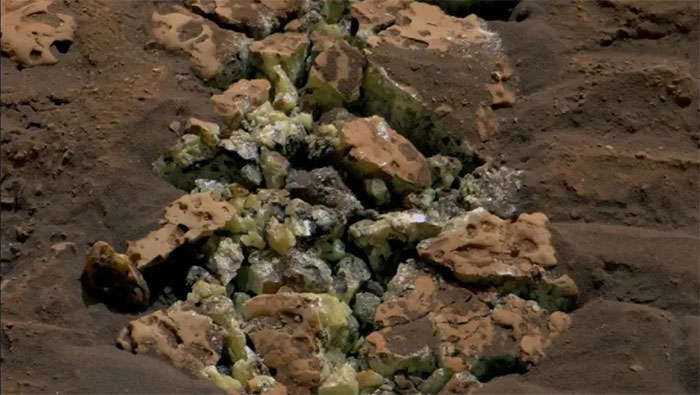NASA robot tripped over rock on Mars, did it detect an earthquake?
While exploring the Gediz Vallis region on Mars, Curiosity accidentally crushed a small rock and discovered strange yellow crystals.
According to Live Science, Gediz Vallis is a canal carved into the slopes of Mount Sharp in the heart of the Gale Crater area, which scientists believe was an ancient river valley where Martian creatures once lived.
Curiosity is a self-driving life-hunting robot that landed on Mars in 2012 and was extremely lucky.
This time, the rock it hit and broke contained something scientists have always hoped to find on other planets: Sulfur crystals .

Yellow crystals that are more precious than gold to scientists have been revealed in a rock that the wheels of the Mars robot Curiosity accidentally crushed - (Photo: JPL/NASA)
When the camera on the robot arm focused on what it had stumbled upon, scientists discovered strange yellow crystals glistening among the newly exposed core.
However, the crystals in this rock are too small and fragile for the rover to handle properly.
Curiosity stopped and searched for a larger rock of the same type. This time, the drill revealed that the yellow crystals were indeed pure sulfur .
Sulfur has been detected on Mars before, but only combined with other elements in compounds called sulfates.
Scientists suspected there might be pure sulfur somewhere on the red planet but were surprised to find it inside surface rocks.
"It shouldn't be there, so now we have to explain it," said Dr Ashwin Vasavada from the Curiosity mission at NASA's Jet Propulsion Laboratory (JPL).
Photos taken around the location where the two rocks were discovered also show many other large and small rocks of the same type scattered around. NASA scientists likened this rock field to an "oasis in the desert".
Sulfur is one of the six NCHOPS elements - including nitrogen, carbon, hydrogen, oxygen, phosphorus and sulfur - that make up the basic structure of organic matter in nature, on Earth.
So astrobiologists have long searched for them on other worlds, because where they are, there is hope for life.
As for Mars, NASA is almost certain that it had life — at least it once did, but it's all gone extinct.
Still, finding more chemical elements related to life and the conditions that support life, as well as how those elements survive in this strange environment, is one step closer to confirming that the red planet was once a "second Earth."
- NASA robots detect precious clues about life on Mars
- NASA's Mars robot turns its head when it encounters a 'crocodile back' rock
- NASA equipped lasers for Mars to explore Mars
- NASA ships find gray stones on the surface of Mars
- NASA announced the first recording of the earthquake on Mars
- NASA lost contact with Mars robots for two weeks
- NASA robots search for 'treasure' on Mars
- NASA postponed the schedule for launching robots to Mars
- Curiosity robot has moved to the foot of Sharp mountain
- China's Mars rock recovery mission went smoothly, NASA encountered difficulties
- The NASA ship found robots landing on Mars
- NASA declares: Humans can live on Mars!
 Announced 3 houses on the Moon and Mars
Announced 3 houses on the Moon and Mars Science proves: Mars also knows 'deflated'
Science proves: Mars also knows 'deflated' Elon Musk announced the price for a Mars trip was 11.6 billion VND, free of charge
Elon Musk announced the price for a Mars trip was 11.6 billion VND, free of charge NASA discovered strange 'gate' on Mars, is the hiding place found?
NASA discovered strange 'gate' on Mars, is the hiding place found?